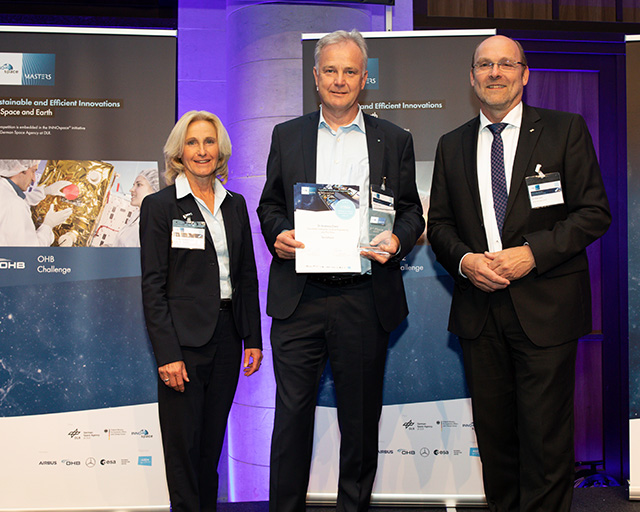Dr. Andreas Dietz from the Fraunhofer IST accepts 3rd place in the INNOspace Masters competition
Bronze for "Ferrotherm"
At the INNOspace Masters conference on July 5th, 2022, Dr. Andreas Dietz of the Fraunhofer Institute for Surface Engineering and Thin Films IST was delighted to reach 3rd place in the INNOspace Masters innovation competition. The “Ferrotherm” project, on which Dr. Dietz is working together with researchers from the Fraunhofer ICT, was awarded a prize as part of the DLR Challenge 2021/2022. The aim is to develop carbon-free energy generation through iron combustion and electrochemical recycling that can also be used on the moon.

Colonization of the moon is one of the greatest challenges of manned space flight. However, energy supply and storage on the moon has remained unsolved to date, especially during the very long and cold lunar nights. The award-winning “Ferrotherm” project could remedy this situation. The researchers are investigating the principle of iron combustion in order to transfer this to a power plant in a later step - analogous to a power plant on Earth. Since there are no fossil fuels on the moon and the resources available there are also finite, the researchers are looking for an approach that is also sustainable in the long term. In the medium term, this process could then also be transferred to energy generation without fossil fuels on Earth. Iron is found on the moon as an oxide in the so-called regolith.
The process is to consider the principle of the circular economy. The existing iron oxide is first reduced electrochemically. This produces metallic iron, which is burned as a powder together with the oxygen that is also produced, generating heat and electricity like in a power plant. The reaction product of the combustion is again iron oxide, which - unlike the analogous CO2 - is solid and can therefore be easily collected and separated back into iron and oxygen in a second step. The particular advantage of this technology is that it can be transferred back to earth. Iron is the fourth most abundant element in the Earth's crust and is sufficiently available. The new process can make a significant contribution to decarbonization, since no CO2 is emitted during energy production. However, this requires providing the energy needed for the cycle process from »green« surplus energy such as photovoltaics or wind energy. “The project offers us an excellent opportunity to pool our diverse competences along the process chain and develop sustainable solutions,” says Prof. Dr.-Ing. Christoph Herrmann, Institute Director of the Fraunhofer IST, delighted at the team's success. “Important innovation contributions from the Fraunhofer IST come from electroplating and other wet chemical processes as well as from life cycle assessment and life cycle engineering.”
On the prize
Every year, the INNOspace Masters competition honors innovative ideas and concepts that deal with the transfer of technologies and applications from space to other industries or, vice versa, adapt existing technologies so that they can also be used for space. This year's theme was »Sustainable and Efficient Innovations for Space and Earth«. The competition is divided into five challenges, each addressing different topics and covering different stages of technological maturity. The winners of all challenges receive technological and economic support for the further implementation of their project.
Last modified: